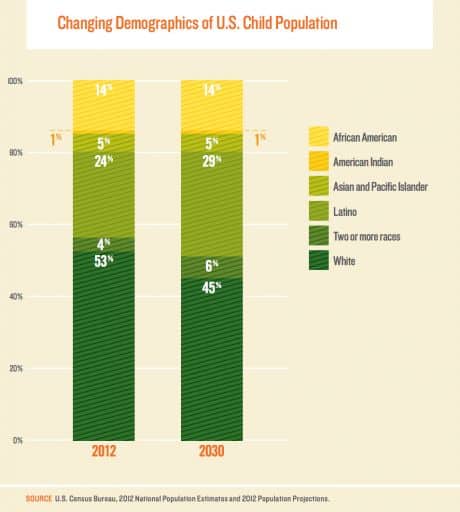Introduction
Black and Latino kids, along with other ethnic minorities, will comprise the majority of U.S. children in four years, but many such kids face multiple obstacles to education and job preparation in certain states, says a new report by the Annie E. Casey Foundation.

African-American kids face especially daunting obstacles in Mississippi, Wisconsin and Michigan. Native American kids face the biggest challenges in South Dakota. Latino children are faring especially poorly in Alabama, Rhode Island and Nevada. West Virginia and Mississippi showed the worst results for white kids. These are among the conclusions of “The Race for Results” report released Tuesday by Casey, a Baltimore-based nonprofit organization dedicated to solving problems faced by families and children.
The stakes are especially high, the report notes, based on the near-term demographics. Latino children, it says, now represent half the child population of California and Texas, the country’s most populous states.
“By 2018,” the report says, “children of color will represent a majority of children. By 2030, the majority of the U.S. labor force will be people of color.”
“The price of letting any group fall behind, already unacceptably high, will get higher,” the report warns. “We are truly in a race against time to deliver better results for our kids.”
To create searchable, state-by-state portraits, the report’s researchers examined 12 indices commonly used to measure the potential for joining the middle class and succeeding. Among these are rates of pre-school enrollment; rates of proficiency at math in 8th grade; rates of children in two-parent families; and rates of young people 25 to 29 who have completed an associate’s degree or higher. Results are disaggregated by ethnicity and state and can be custom built for communities.
No one ethnic group nationally was at the top of all milestones measured. But overall, Asian and Pacific Islander children ranked first, with an index score of 776 out of a 1,000 possible points. White kids scored 704 and Latino, Native-American and African-American kids nationally were ranked “distressingly lower,” the report said, at 404, 387 and 345, respectively.
Among the states with relatively substantial Asian populations, Asian kids did best in New Jersey, Maryland and Illinois. White kids scored highest in Massachusetts and New Jersey. And Latinos fared best, among states with significant Hispanic populations, in Virginia, Maryland and Florida. Black kids did best in Massachusetts and Maryland, among states that have a sizable African-American demographic.
Research cited in the report found that if the academic performance of Latino and African-American children had caught up with white children by 1998, the country’s gross domestic product in 2008 would have been $525 billion greater. In addition to issuing state-by-state findings, the report recommends programs and policies that have succeeded in lifting up children facing disadvantages.
Among the programs the report highlights are the Parents as Teachers National Center (PAT) early-reading program, which has proven effective at helping better prepare minority children for kindergarten. The report also suggests using data analysis to target investments to reach children in communities that most need support. These same communities, the report urges, can benefit from targeted plans to include families in workforce development and job creation.
The Center for Public Integrity has received grants from the Annie E. Casey Foundation to pursue independent reporting.
Read more in Education
Juvenile Justice
Tennessee Supreme Court declines to review case featured in Center report
Truant was jailed twice at 13, allegedly without first being informed of right to counsel
Juvenile Justice
Abuse in court? Deputy strikes boy in court, boy charged with assault
Tennessee judge, sheriff’s department behavior under scrutiny

Join the conversation
Show Comments